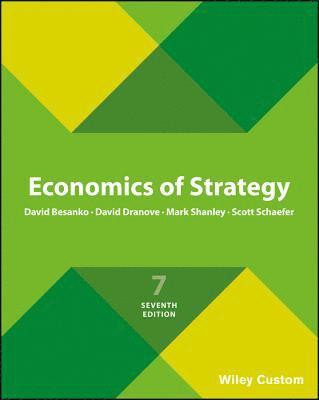
- Format
- Häftad (Paperback / softback)
- Språk
- Engelska
- Antal sidor
- 544
- Utgivningsdatum
- 2017-02-03
- Upplaga
- 7 ed
- Förlag
- John Wiley & Sons Inc
- Dimensioner
- 276 x 213 x 25 mm
- Vikt
- Antal komponenter
- 1
- ISBN
- 9781119378761
- 959 g
Economics of Strategy
- Skickas från oss inom 5-8 vardagar.
- Fri frakt över 249 kr för privatkunder i Sverige.
Passar bra ihop
De som köpt den här boken har ofta också köpt Slow Productivity av Cal Newport (häftad).
Köp båda 2 för 917 krKundrecensioner
Fler böcker av författarna
-
Kellogg on Strategy
David Dranove, Sonia Marciano
-
Microeconomics, EMEA Edition
David Besanko, Ronald Braeutigam
-
Roadside Mba
Michael Mazzeo, Paul Oyer, Scott Schaefer
-
Corporate Reputation and Social Activism
Jose Muguel Abito, David Besanko, Daniel Diermeier
Innehållsförteckning
INTRODUCTION: STRATEGY AND ECONOMICS Why Study Strategy? Why Economics? So Whats the Problem? A Framework for Strategy The Book Endnotes ECONOMICS PRIMER: BASIC PRINCIPLES Costs Economic Costs and Profitability Demand and Revenues Total Revenue and Marginal Revenue Functions Theory of the Firm: Pricing and Output Decisions Perfect Competition Game Theory Chapter Summary Questions Endnotes PART ONE FIRM BOUNDARIES 1 THE POWER OF PRINCIPLES: AN HISTORICAL PERSPECTIVE Doing Business in 1840 Doing Business in 1910 Doing Business Today Three Different Worlds: Consistent Principles, Changing Conditions, and Adaptive Strategies Chapter Summary Questions Endnotes 2 THE HORIZONTAL BOUNDARIES OF THE FIRM Definitions Scale Economies, Indivisibilities, and the Spreading of Fixed Costs Special Sources of Economies of Scale and Scope Complementarities and Strategic Fit Sources of Diseconomies of Scale The Learning Curve Diversification Why Do Firms Diversify? Managerial Reasons for Diversification The Market for Corporate Control and Recent Changes in Corporate Governance Performance of Diversified Firms Chapter Summary Questions Endnotes 3 THE VERTICAL BOUNDARIES OF THE FIRM Make versus Buy Reasons to Buy Reasons to Make Summarizing Make-or-Buy Decisions: The Make-or-Buy Decision Tree Chapter Summary Questions Endnotes 4 INTEGRATION AND ITS ALTERNATIVES What Does It Mean to Be Integrated? Governance Making the Integration Decision Real-World Evidence Alternatives to Vertical Integration Chapter Summary Questions Endnotes PART TWO MARKET AND COMPETITIVE ANALYSIS 5 COMPETITORS AND COMPETITION Competitor Identification and Market Definition Measuring Market Structure Market Structure and Competition Oligopoly Evidence on Market Structure and Performance Chapter Summary Questions Endnotes 6 ENTRY AND EXIT Some Facts about Entry and Exit Entry and Exit Decisions: Basic Concepts Entry-Deterring Strategies Evidence on Entry-Deterring Behavior Contestable Markets An Entry Deterrence Checklist Entering a New Market Chapter Summary Questions Endnotes 7 DYNAMICS: COMPETING ACROSS TIME Microdynamics Impediments to Coordination Asymmetries among Firms and the Sustainability of Cooperative Prices Facilitating Practices Where Does Market Structure Come From? Suttons Endogenous Sunk Costs Chapter Summary Questions Endnotes 8 INDUSTRY ANALYSIS Performing a Five-Forces Analysis Coopetition and the Value Net Applying the Five Forces: Some Industry Analyses Chapter Summary Questions Endnotes PART THREE STRATEGIC POSITION AND DYNAMICS 9 STRATEGIC POSITIONING FOR COMPETITIVE ADVANTAGE Competitive Advantage and Value Creation: Conceptual Foundations Strategic Positioning: Cost Advantage and Benefit Advantage Diagnosing Cost and Benefit Drivers Strategic Positioning: Broad Coverage versus Focus Strategies Chapter Summary Questions Endnotes 10 INFORMATION AND VALUE CREATION The Shopping Problem Report Cards The Certifier Market Matchmaking Chapter Summary Questions Endnotes 11 SUSTAINING COMPETITIVE ADVANTAGE Market Structure and Threats to Sustainability The Resource-Based Theory of the Firm Impediments to Imitation Early-Mover Advantages Imperfect Imitability and Industry Equilibrium Creating Advantage and Creative Destruction Innovation and the Market for Ideas Evolutionary Economics and Dynamic Capabilities The Environment Chapter Summary Questions Endnotes PART FOUR INTERNAL ORGANIZATION 12 PERFORMANCE MEASUREMENT AND INCENTIVES The PrincipalAgent Relationship Performance-Based Incentives Problems with Performance-Based Incentives Performance Measures That Fail to Reflect All Desired Actions Selecting Performance Measures: Managing Trade-offs between Costs Do Pay-
Du kanske gillar
-
Transformed
Marty Cagan
Inbunden


